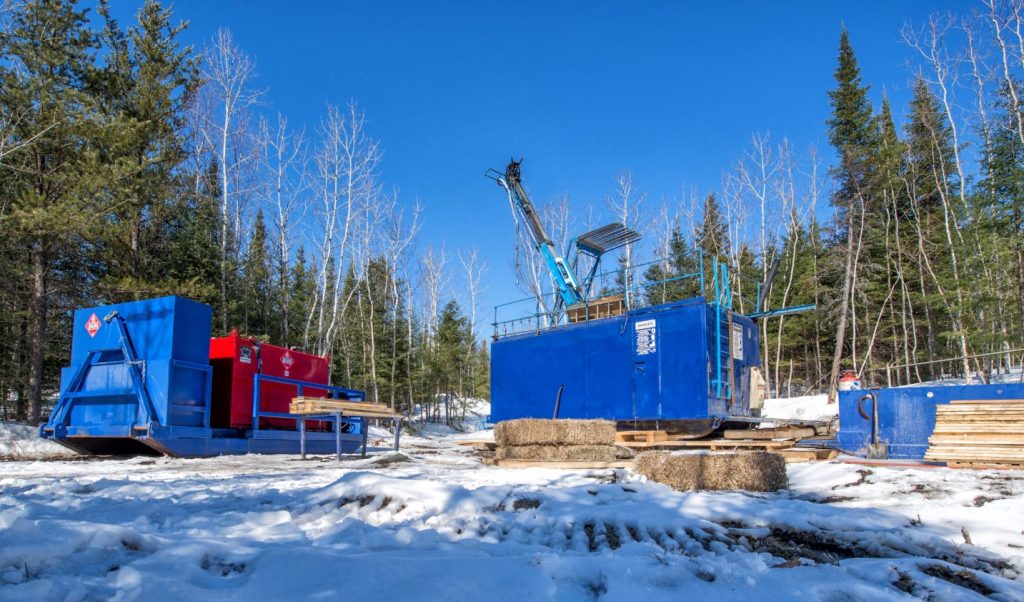MacDonald Mines drills 0.47% copper over 25 metres at SPJ project, Ontario

MacDonald Mines Exploration Ltd. [TSXV-BMK; OTC-MCDMF] reported results from its 1,206-metre drill program along the prospective McLaren Lake fault zone (MLFZ) at the Alwyn copper-gold (Cu-Au) trend, as well as the Glade gold trend located on MacDonald Mines’ 100%-owned SPJ project near Sudbury, northern Ontario.
“We are extremely pleased with the results at Alwyn, which continue to confirm the potential of a robust mineral system capable of forming IOCG [iron oxide-copper-gold] or affiliated deposits at depth. Company personnel are actively pursuing various options to prepare for a follow-up drill program at Alwyn, directed towards expanding Cu-Au mineralization in the 102 vein and testing the most favourable geophysical targets at depth to the southeast,” stated Mike England, chief executive officer of MacDonald Mines.
Highlights from 954 metres of drilling in the Alwyn Cu-Au trend: Copper-gold mineralization confirmed in the Alwyn Trend over a strike length of approximately 400 metres. The Alwyn Cu-Au trend is part of the MacLaren Lake Fault Zone (MLFZ). Other known centers of Cu-Au mineralization along the MLFZ includes the Ashigami and Crerar showings respectively located 4.5 km and 9.5 km SE from the Alwyn prospect
Confirmation that the Alwyn 102 Vein is contained within a broader halo of Cu-Au mineralization is extending at least 75 metres SE of the historical Alwyn mine. Near-surface intersection of 1.16% Cu and 1.64 g/t gold over 4.75 metres within a mineralization halo containing 0.47% copper and 0.52 g/t gold and over 25 metres in AW-23-107. Located 30 metres away from the intersection of 1.07% copper and 3.01 g/t gold over 4.2 metres in AW-22-102; 1.36% copper and 3.06 g/t gold over 0.90 metres associated with garnet-amphibole alteration in AW-23-106 within a Cu-Au mineralization halo containing 0.31% copper and 0.31 g/t gold over 16.0 metres.
There are zones of pervasive magnetite alteration with indications of copper mineralization in AW-23-110 identified in the Alwyn Cu-Au trend. Magnetite alteration is indicative of mineral systems capable of forming IOCG and affiliated deposits.
In AW-23-109 and AW-23-110, the zones of pervasive magnetite alteration are located at the edge of aeromagnetic and gravity highs. This is supporting a possible relation between the geophysical anomalies and magnetite and iron-rich alteration. Magnetite is primarily disseminated in replacement fronts and is also forming localized veins, and was observed down to approximately 160 m vertical depth in AW-23-110. Indications that parallel zones of Cu-Au mineralization exist in the Alwyn Cu-Au trend. AW-23-107 discovered a new zone of Cu-Au mineralization located south of the Alwyn 102 Vein and its mineralized halo. AW-23-108A intersected Cu-Au mineralization north of the Alwyn Cu-Au 102 Vein
A diabase dyke truncated the core zone of the Alwyn 102 Vein and its mineralized halo in AW-23-109 and AW-23-110. Cu-Au mineralization associated with the halos of the Alwyn 102 Vein is observed in both holes above and below the upper and lower contacts of the diabase dyke.
Highlights from 252 metres of drilling in the Glade Au trend: Many zones of gold mineralization intersected; supports the continuity of gold mineralization at depth in the Glade Au trend.
The company continues to investigate opportunities to advance the exploration and potential development of the high-grade gold zones of the Scadding deposit that remain open laterally and at depth for further exploration.
Significant drill intersections in the North Zone of the Scadding deposit include 52.03 g/t gold over 12.3 metres in SM-19-001, including 210.27 g/t gold over 2.95 metres; 376.75 g/t gold over 2.96 metres in SM-20-026.
The MLFZ is emerging as a compelling exploration target for Cu-Au and potentially Co-Au mineralization affiliated with mineral systems capable of forming IOCG and affiliated deposits. Along the 2.5 km-long Alwyn Cu-Au trend defined in collaboration with ALS-GoldSpot, near-surface Cu-Au mineralization is associated with networks of quartz-carbonate veins with zones of stronger Cu-Au mineralization concentrated in the Alwyn 102 Vein.
The 2023 drilling program confirmed the existence of pervasive magnetite alteration zones in the SE extension of the Alwyn Cu-Au trend at the edge of positive magnetic anomalies overlapping with gravity anomalies. Many drill holes from the 2022 and 2023 drilling programs also contain chalcopyrite mineralization associated with the development of iron-rich alteration types.
Regionally, the MLFZ is highly prospective for critical and precious metals mineralization. In addition to Alwyn, along the MLFZ on the SPJ Project the primary targets include the Ashigami and Crerar showings, located 4.5 km and 9.5 km southeast of the Alwyn mine, respectively.
MacDonald Mines is focused on exploring for critical and precious metals in a Metasomatic Iron alkali-calcic (MIAC) mineral system on its 100%-owned, 19,720 ha (197.2 km2) SPJ Project. The property is located 20 km southeast of the prolific Sudbury Mining Camp, northern Ontario. In addition, a potential for nickel, cobalt, copper, and platinum group elements in the Nipissing intrusions that are hosting the Candore, Jerome and Glade showings within the SPJ Project.
